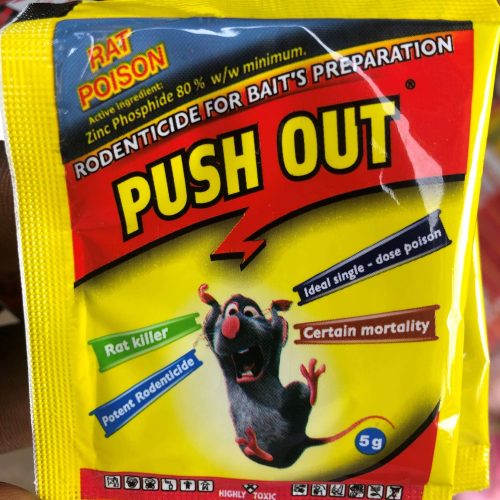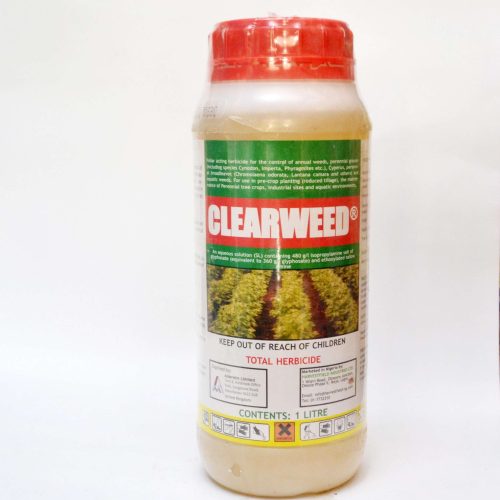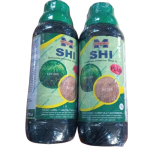Description
SHI Herbicide | 1L bottle contain a soluble liquid concentrate formulation of the herbicide glufosinate-ammonium, standardized to deliver 20 grams of the active ingredient per litre of product. It is designed to be diluted with water in a spray tank according to label recommendations for the target weeds and application site.
Key Characteristics of SHI Herbicide | 1L:
-
Active Ingredient (AI): Glufosinate-ammonium (200 g/L or 20% w/v equivalent to 20g/L).
-
Formulation: SL (Soluble Liquid Concentrate) – Dissolves readily in water to form a true solution for spraying.
-
Mode of Action: Contact, Non-Selective Herbicide with slight translaminar movement.
-
Inhibits the enzyme glutamine synthetase (GS), crucial for nitrogen metabolism and ammonia detoxification in plants.
-
Causes rapid accumulation of toxic ammonia levels, disrupting photosynthesis and leading to cell membrane destruction.
-
-
Spectrum: Broad-spectrum – Effective against a very wide range of annual and perennial broadleaf weeds and grasses.
-
Speed of Action: Fast-acting (burndown herbicide). Visible symptoms (wilting, yellowing, necrosis) typically appear within 2-5 days under good conditions, with complete kill in 1-3 weeks depending on weed size, species, and environmental conditions.
-
Residual Activity: Minimal to None. Primarily kills the plant tissue it contacts. Does not persist significantly in the soil, allowing for planting or sowing relatively soon after application (consult specific label for crop rotation restrictions).
-
Rainfastness: Good. Generally rainfast within 4-6 hours after application (check specific product label).
-
Resistance Management: A valuable tool for managing weeds resistant to other herbicide groups (e.g., glyphosate, ALS inhibitors, ACCase inhibitors).
Primary Applications of SHI Herbicide | 1L:
-
Pre-Plant Burndown: Widely used to control existing weeds before planting various field crops (e.g., soybeans, cotton, corn, cereals), vegetables, and plantation crops. Provides a clean seedbed.
-
Pre-Emergence in Orchards, Vineyards & Plantations: Essential for directed spray or shielded spray weed control in established:
-
Fruit trees (Citrus, Pome, Stone fruit, etc.)
-
Nut trees (Almonds, Walnuts, etc.)
-
Vineyards (Grapes)
-
Plantation crops (Coffee, Tea, Oil Palm, Rubber, etc.)
-
Forestry
-
Critical: Spray must be directed under the crop canopy or use shields to avoid contact with green bark, leaves, or fruit of the desirable crop, as it is non-selective.
-
-
Directed Spray in Row Crops: Used post-emergence of the crop but only as a directed spray between rows or under the crop canopy, avoiding contact with the crop itself (e.g., in taller corn, cotton, sugarcane).
-
Chemical Fallow: Controlling weeds during fallow periods between crops.
-
Stale Seedbed: Controlling emerged weeds after initial seedbed preparation but before crop emergence.
Critical Application Considerations:
-
Contact Herbicide: Thorough and even spray coverage is essential. Use sufficient water volume and appropriate nozzles to ensure all weed foliage is wetted. Incomplete coverage leads to poor control, especially of grasses.
-
Weed Size Matters: Most effective on small, actively growing weeds (generally < 15 cm tall or across for broadleaves, before tillering for grasses). Control diminishes significantly on large, mature, or stressed weeds.
-
Environmental Conditions: Works best under warm, humid, sunny conditions promoting active weed growth.
-
Avoid Crop Contact: EXTREMELY IMPORTANT. Glufosinate will severely damage or kill any green plant tissue it contacts, including crops. Use proper spray shields and precise application techniques in established crops.
-
Tank Mixing: Frequently tank-mixed with other herbicides (like residual soil-applied products) or other glufosinate products for broader spectrum or extended control.
Additional information
| Weight | 6 kg |
|---|








Reviews
There are no reviews yet